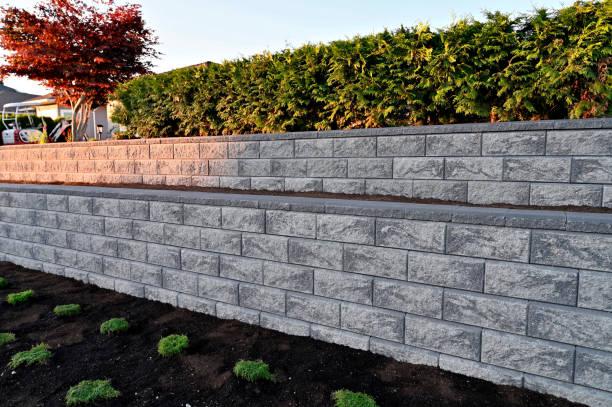
Proudly Serving: Grand Isle, Franklin & Chittenden Counties, VT and Clinton County, NY

Unveiling the Beauty and Utility of Stone Retaining Walls in Grand Isle County, Vermont
Nestled in the picturesque landscapes of Grand Isle County, Vermont, lies a timeless feature that not only enhances the natural beauty of the area but also serves a crucial purpose in landscaping—stone retaining walls. These walls, crafted from locally sourced materials, stand as testaments to both the artistry and functionality that define the region's aesthetic. In this article, we'll delve into the allure and practicality of Stone Retaining Walls in Grand Isle County, Vermont, addressing common questions and offering insights into their construction and benefits.
1. What are Stone Retaining Walls?
Stone retaining walls, often referred to as wallstone retaining walls, are structures built to hold back soil and prevent erosion on slopes or uneven terrain. These walls are meticulously crafted from durable stones, carefully arranged to create a barrier that withstands the forces of nature while complementing the natural surroundings.
2. Why Choose Stone Retaining Walls?
- Aesthetic Appeal: Stone retaining walls add rustic charm and visual interest to any landscape, blending seamlessly with the natural environment of Grand Isle County.
- Durability: Constructed from sturdy materials, such as granite or fieldstone, these walls are built to withstand the test of time, requiring minimal maintenance.
- Versatility: Whether used to terrace a sloping yard, create garden beds, or define outdoor living spaces, stone retaining walls offer endless design possibilities.
- Environmental Benefits: By preventing soil erosion, these walls help preserve the integrity of the land, promoting sustainability and conservation efforts in the region.
3. How are Stone Retaining Walls Constructed?
The construction of stone retaining walls requires careful planning and precise execution. Here's an overview of the typical process:
- Site Assessment: Assess the terrain to determine the layout and placement of the wall, considering factors such as slope, soil composition, and drainage.
- Foundation Preparation: Excavate the area and create a sturdy foundation using gravel or crushed stone to ensure proper drainage and stability.
- Stone Selection: Choose stones of varying sizes and shapes, selecting those that complement the landscape and fit together snugly.
- Building the Wall: Begin stacking the stones, interlocking them to create a stable structure. Backfill behind the wall as you progress, compacting the soil to provide additional support.
- Finishing Touches: Cap the wall with flat stones or concrete coping to enhance its appearance and provide a smooth surface.
4. What are the Benefits of Stone Retaining Walls?
- Erosion Control: By holding back soil and preventing runoff, stone retaining walls help protect against erosion, preserving the integrity of the land.
- Functional Landscaping: Create level terraces for planting gardens, installing patios, or adding seating areas, maximizing the usable space in your yard.
- Property Value: Enhance the curb appeal and value of your property with beautifully crafted stone retaining walls that enhance the overall aesthetic.
- Longevity: Unlike traditional timber or concrete walls, stone retaining walls are built to last, requiring minimal maintenance over their lifespan.
5. Common Questions about Stone Retaining Walls:
Q: Will a stone retaining wall require maintenance?
A: Stone retaining walls are relatively low-maintenance, requiring periodic inspection for any signs of damage or shifting. Minor adjustments may be needed over time, but routine upkeep is minimal.
Q: Can I build a stone retaining wall myself, or should I hire a professional?
A: While DIY enthusiasts may tackle smaller projects, larger or more complex installations are best left to experienced professionals. Proper construction techniques are essential to ensure the stability and longevity of the wall.
Q: Are stone retaining walls environmentally friendly?
A: Yes, stone retaining walls are environmentally friendly as they help prevent soil erosion and promote sustainable land management practices. Additionally, using locally sourced materials reduces carbon emissions associated with transportation.
Conclusion:
In Grand Isle County, Vermont, stone retaining walls stand as enduring symbols of craftsmanship and functionality, blending seamlessly with the natural landscape while serving a vital purpose in landscaping and erosion control. Whether enhancing the beauty of a residential property or preserving the integrity of a commercial site, these walls offer both aesthetic appeal and practical benefits. By understanding the construction, benefits, and maintenance of stone retaining walls, property owners can make informed decisions to enhance their outdoor spaces for years to come.
All rights reserved | Privacy policy | Client Support Area
Disclaimer: Septic inspection credit is applied to septic installations only and must be redeemed within 7 days after a written quote provided upon state acceptance of design.
Disclaimer: Septic soil test credit is applied to septic installations only and must be redeemed within 7 days after a written quote provided upon state acceptance of design.



